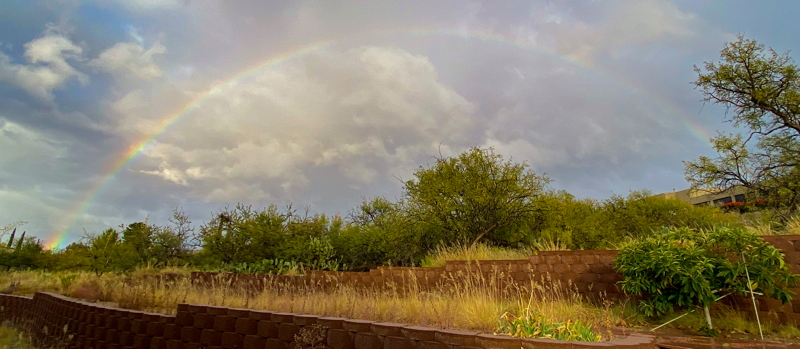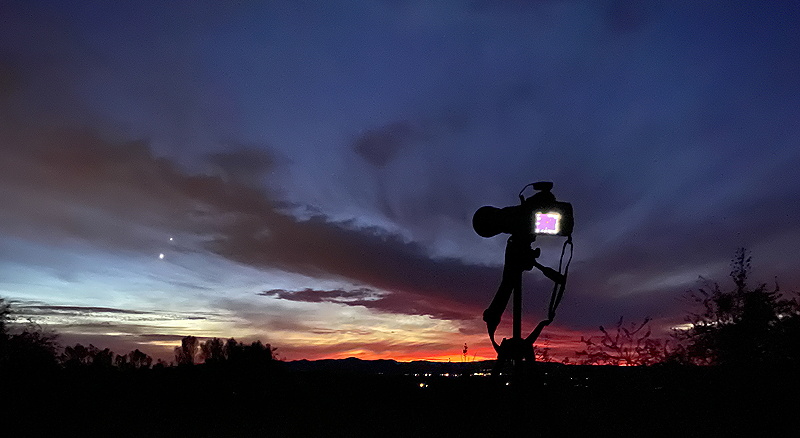Weather Updates;
Jupiter-Venus Conjunction
Posted: 23 November 2019
Cloudy skies began Friday, 15 November 2019, and continued until Sunday, 17 November. However, due to the very hazy conditions Sunday night I didn't open the observatory. Clouds began arriving Monday morning, 18 November. Tuesday afternoon, 19 November, a thunderstorm arrived (0.4" rain in about 45 minutes). Total rain for the day was 0.5". There was more rain (1.12") on Wednesday, 20 November, with a nice rainbow late afternoon.

Rain (0.7") continued on Thursday, 21 November. That morning I went to the observatory and discovered a problem with the electricity there. The GFCI is getting power (its LED is on). I tried testing and resetting the GFCI but nothing happened. I measured the output from the outlets at 40-50 VAC (should have been 120 VAC). I called the electrician who did the outlets installation. Fortunately he was still in business and remembered doing the original installation on our home and observatory in 2009. Although no moisture from the recent heavy rains was obvious, he said to wait a couple of days to let the GFCI possibly dry out. I checked the GFCI again on Saturday; still only get 40-50 VAC. Will check again on Monday, 25 November.
Friday, 22 November, dawned mostly clear after some early morning rain (0.1"), but became mostly cloudy by mid-day. After sunset the sky was clear enough to observe the conjunction of Jupiter and Venus; they were 2° apart. This iPhone 11 Pro Max photo (1X normal lens) shows the planets Saturn, Jupiter, amd Venus, with the International Space Station (ISS) crossing the sky.

Mouseover or tap on image for labels
This iPhone photo shows the ISS passing by Vega and the constellation of Lyra.

Saturday, 23 November, dawned partly cloudy and windy. As sunset approached the sky was mostly cloudy. I decided to try to photograph the Jupiter-Venus conjunction, which was 1.5° this night. I set up the D850 DSLR and 150-600mm lens. This iPhone 11 Pro Max photo shows Cassiopeia Observatory, Kitt Peak National Observatory, and Venus just peaking out from behind a cloud.

Mouseover or tap on image for labels
This D850 photo (FL 150mm) shows the clouds over Kitt Peak and Cassiopeia observatories.

1759 MST: Jupiter (top) finally made an appearance through the clouds, joining Venus (bottom) (FL 600mm).

1809 MST: Jupiter and Venus were shining fairly brightly through the clouds (iPhone photo).

1815 MST: conditions continued to be pretty bad (FL 150mm).

1816 MST: this photo (FL 600mm) captured both planets through the clouds and three of the Galilean Moons at Jupiter (inset).

I attended the International Dark-Sky Association "Annual General Meeting" earlier this month in Tucson, Arizona. I was a speaker on one of the panels (top photo). See if you recognize any of the attendees (bottom photo).


Photos Credit: Karen Wright for International Dark-Sky Association
Comments are welcome using Email. Twitter users can use the button below to tweet this report to their followers. Thanks.
Cassiopeia Observatory Home Page
Copyright ©2019 Michael L. Weasner / mweasner@me.com
URL = http://www.weasner.com/co/Reports/2019/11/23/index.html
